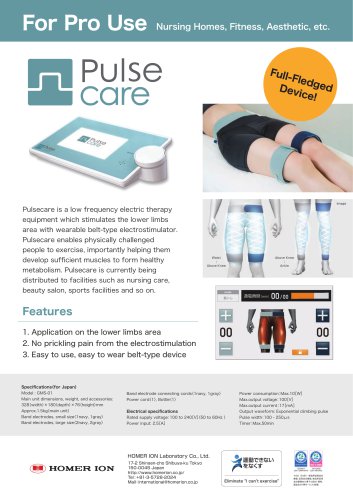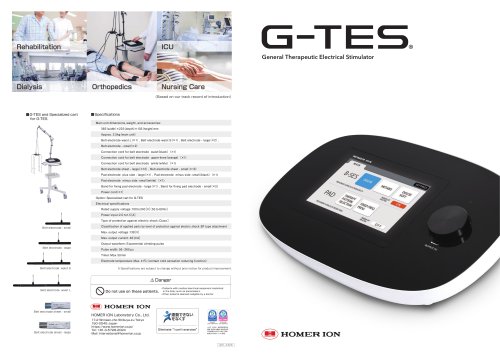 Website:
HOMER ION Laboratory
Website:
HOMER ION Laboratory
Catalog excerpts

Features of Belt Electrode-Skeletal Muscle Electrical Stimulation
Open the catalog to page 1
Problems in Exercise-Deficient People ●Aging ●Unfamiliarity with exercise ●Pain ●Orthopedic disease ●Respiratory disease ●Cardiovascular disease ●ICU Exercise-deficient people have a higher risk of being bedridden or requiring n
Open the catalog to page 2
Problems in Exercise-Deficient People Muscle weakness Incapable of exercise Negative cycle Progress of primary disease Decrease in will to exercise Exercise is more required in people who “cannot exercise”/ “do not exerci
Open the catalog to page 3
B-SES is a Therapy Substituting for Voluntary Movement Capable of moving the muscles in a wide range at once for strength training and aerobic exercise as a substitute for voluntary movement
Open the catalog to page 4
Belt Electrodes Move the Muscles in the Lower Extremities as a Substitute for Voluntary Movement Performs strength training and aerobic exercise by purpose Disuse (strength training) Causing muscle tetanus at 20 Hz to cause strong muscle contraction and perform exercise for strength training in voluntary movement Metabolism (aerobic exercise) Repeatedly twitching at 4 Hz for aerobic exercise in voluntary movement
Open the catalog to page 5
Movie of Exercise with B-SES
Open the catalog to page 6
Features of B-SES Belt Electrodes Advantage1 : Wide Range of Approach Belt electrodes move the muscles of the lower extremities as a substitute for voluntary movement Pad electrodes Belt electrodes
Open the catalog to page 7
Features of B-SES Belt Electrodes Advantage2 : No pain Large contact area The larger electrode areas and skin contact areas scatter potential density to cause no pain from the electrodes. Strong muscle contraction can also be performed without pain. Pad electrode with small contact area Belt electrode with large contact area
Open the catalog to page 8
Features of B-SES Belt Electrodes Advantage3 : Easy to Put on Easily put on just by wrapping the belt Motor points The large electrodes enable anyone to perform the same therapy regardless of motor points with high treatment reproducibility. User-friendliness Searching motor point Number of electrodes Treatment reproducibility Using belt electrodes Motor points : Points with dense neuromuscular junctions to which current is applied to move the muscle
Open the catalog to page 9
Range of Skeletal Muscle Activity with B-SES Measured by PET-CT • Twelve healthy individuals were divided into six cases in an exercise group and six cases in a control group. In the exercise group, B-SES was performed for 20 minutes (20 Hz) and skeletal muscle activity, including the inner muscle, was evaluated using PET-CT. The mean standardized uptake value (SUV) was significantly higher in the exercise group than in the control group for the gluteus maximus, gluteus medius, gluteus minimus, rectus femoris, vastus lateralis, vastus intermedius, vastus medialis, sartorius, semitendinosus,...
Open the catalog to page 10
Effect of B-SES: Effect on Muscle Strength and Cardiopulmonary Function • Nineteen healthy individuals were assigned to the control group (CON: 8 cases) and the intervention group (INT: 11 cases). The intervention group had electrical stimulation applied for 30 minutes per session (4 Hz) four times a week over four weeks. • The change rate in isometric knee extension muscle strength was significantly higher in the intervention group than in the control group (4.6 ± 5.3% vs. 23.7 ± 4.6%). • The relative change rates of VO2 at VT and VO2peak both had significant increases in the intervention...
Open the catalog to page 11
Clinical Use of B-SES Orthopedics Moves the muscles of the lower extremities in exercise-deficient persons Institutions with B-SES introduced Introduced in more than 1000 institutions nationwide ※As of April 2022
Open the catalog to page 12
Clinical Use of B-SES Move people who cannot move/ do not move to enable rehabilitation that they could not do before Method of use standardized by JRSE※ Contribution to medical care with unprecedented treatment ※ JRSE: Japan Research Society of Skeletal Muscle Electrical Stimulatio
Open the catalog to page 13
Clinical Study of B-SES Belt 1 : Decrease in Muscle Mass Reduction Rate in Severe Patients in ICU • Ninety-four ICU patients were assigned to the EMS group and the control group (without intervention), and 21 cases in the EMS group and 16 cases in the control group were eventually analyzed. • Intervention was initiated on day 2 of ICU admission. In the EMS group, treatment was performed for 20 minutes (20 Hz) once daily. • The femoral volume measured by CT decreased from day 1 to day 10 in both groups. While the reduction rate in the control group was 17.7%, the rate was 10.4% in the EMS...
Open the catalog to page 14
Clinical Study of B-SES Belt 2 : Useful Effects on Muscle Strength and Muscular Cross-Section Area in Dialysis Patients • Twenty-nine dialysis patients were assigned to the electrical stimulation group and the control group (without intervention) and 13 cases were analyzed for each case. • In the electrical stimulation group, treatment (20 Hz) was performed for 20 minutes three times a week over eight weeks during dialysis. • The electrical stimulation group had significant increases in right and left knee extension muscle strength compared to the control group. • The right and left...
Open the catalog to page 15
Basic Research of B-SES 1 : Mechanism of Onset of Muscle Contracture and Effect on It Eighteen rats were divided into the control group, fixation group (fixing the soleus muscles with gypsum), and the B-SES group (B-SES while fixing the soleus muscles with gypsum), and the bilateral soleus muscles were analyzed for two weeks. The number of muscle nuclei was higher in the B-SES group than in the fixation group, and there was no significant difference between the control group and the B-SES group. The macrophage count, expressions of IL-1β, TGF-β1, and α-SMA mRNA, and hydroxyproline...
Open the catalog to page 16
Clinical Study of B-SES Belt 3 : Useful Effects on Spasmodic Status and Range of Motion in Bedridden Elderly Patients • To 18 bedridden elderly patients with severe frailty, treatment was administered for 20 minutes (4 Hz) per session to investigate immediate effect before and after the treatment. • ROM and MAS in four joint movements: hip joint flexion and abduction and knee joint flexion and extension were all greatly improved after the treatment. • Sixteen bedridden elderlies with severe frailty were randomly assigned to the preceding passive exercise group (8 cases) and the preceding...
Open the catalog to page 17All HOMER ION Laboratory catalogs and technical brochures
-
PulseCare+PulseTrainer
2 Pages
-
G-TES_catalog
2 Pages



